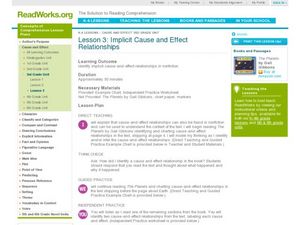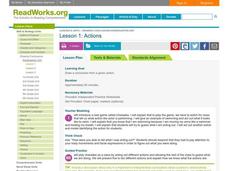Curated OER
Causes
What makes someone cry? Little learners read the story, Why Do You Cry?: Not a Sob Story by Kate Klise to discover a bit about crying and a bit about cause and effect. They'll fill out a cause and effect chart while they discuss and...
Curated OER
Lesson 1: Explicit Information versus drawing conclusions
Second graders look at the difference between explicit information and drawing conclusions. For this drawing conclusions lesson, 2nd graders read a passage and find areas where information is given and others where they have to think to...
Curated OER
Lesson 2: Distinguish Fact from Opinion in Books
An important part of reading informational text is being able to discern fact from opinion. The class reads chapter one from the book, Penguins by Lynn M. Stone. They analyze specific sections of the text to determine if what is being...
Curated OER
Personification
Second graders recognize personification in texts. In this personification lesson plan, 2nd graders discuss figurative language and how characters can be given human-like qualities. Students read a story and write down examples they...
Curated OER
Creating a Chapter Title
Second graders identify the main idea of a selection of text. In this creating a chapter title lesson, 2nd graders discuss how to find the main idea of a chapter, listen to a chapter read aloud, and create a title with explanation.
Curated OER
Identifying Story Elements
Second graders explore story elements. In this language arts lesson, 2nd graders identifying characters, setting, and plot in familiar stories. Students listen to a story and complete a graphic organizer.
Curated OER
Flashback Sequence
Second graders practice recalling the sequence of events in a story. For this sequencing lesson, 2nd graders listen to the story, A Chair for My Mother and identify each flashback that occurs in the text. Students chart the sequence of...
Curated OER
Changing Setting in a Story
Second graders explore how the setting in a story changes throughout. In this language arts lesson, 2nd graders read a story and identify the setting at various points within the story. Students describe the changes in setting.
Curated OER
Lesson 2: Identifying an Author's Purpose (part 2)
Keep reinforcing the concept of author's purpose with a practice activity. After discussing the three purposes of writing, third graders will complete a graphic organizer intended to help them pin point textual evidence that proves...
Curated OER
Lesson 1:Cause and Effect Signal Words
Give your class a strategy they can use when trying to identify cause and effect relationships in text. You'll model, and they'll practice using signal words to quickly identify cause and effect. They focus on signal words such as, if,...
Curated OER
Implicit Cause and Effect Relationships
Cause and effect relationships can be found in both fiction and non-fiction texts. As they read the book, The Planets by Gail Gibbons, learners keep an eye out for cause and effect relationships. They chart all of the causes and effects...
Curated OER
Using Evidence to Describe a Character
It's all about the details found in the text, when children attempt to describe the main character from the story, Burnt Toast on Davenport Street. They first discuss the process by which one would go about using textual evidence and...
Curated OER
Realistic Fiction
Explore the characteristics of realistic fiction by reading and then analyzing the book, Allie’s Basketball Dream by Barbara E. Barber. Using the I do, we do, you do model, learners practice identifying realistic fiction based on how...
Curated OER
Main and Secondary Characters
Identify main and secondary characters from a fiction story. Kindergartners do a picture walk with the teacher, and then do the identifying on their own with another book. A good assignment for groups or a whole class to complete.
Curated OER
Identifying What is Different
What is the same, what is different, and what does it all mean? Introduce the concept of identifying similarities and difference to your Kinder class using the I do, we do, you do, instructional approach. You'll provide structured...
Curated OER
Actions
Learners pair up and one of the students acts out an action while the other draws conclusions from their actions by drawing a picture of what they are doing. In this actions lesson plan, learners play charades and guess what each other...
Curated OER
Opinion
An important concept for youngsters to learn is that there is a difference between facts and opinions. Use Kirsten Hall's Animal Touch to introduce the idea that an opinion is how one feels or thinks about something and that others are...
Curated OER
Identifying Facts and Forming Opinions
Kirsten Hall's animal books provide learners with an opportunity to practice forming statements of opinions and factual statements. Using sentence starters such as "I learned. . ." and "I think. . ." class members craft sentences cite a...
Curated OER
Tells a Story
Students discover the concept of a biography. In this biography lesson, students read, A Picture Book of Amelia Earhart by David A. Adler. They see how biographies tell a story and then work together to identify the beginning, middle,...
Curated OER
Good and Evil Characters
What makes a character good or evil? Young readers discuss the characteristics and actions of good and evil characters in given fairy tales. They then read Snow White and discuss the characters in the story.
Curated OER
Fantasy Details
Students identify fantasy details from a fairy tale they have read and give an explanation of how they know it is a fantasy detail. In this fantasy detail lesson plan, students make a list from the fairy tale Little Red Riding Hood.
Curated OER
Pictures and Photographs
Students write the facts that they learned from the photographs in the book All About Cats and Kittens. In this pictures and photographs lesson plan, students present their fact to the class and add it to the chart.
Curated OER
When (Seasons, Day, or Night)
Practice identifying the setting with a reading activity. Kindergartners find the setting of a story by observing when the story takes place. They read the book Look! Snow! by Kathryn O. Galbraith and decide in which season the story...
Curated OER
Sorting Based on Character Traits
Characters from a story can be sorted by their traits, just like shapes or objects can. First the children list several character traits on a chart, they read a familiar story, and then sort the characters by their friendly or unfriendly...

























